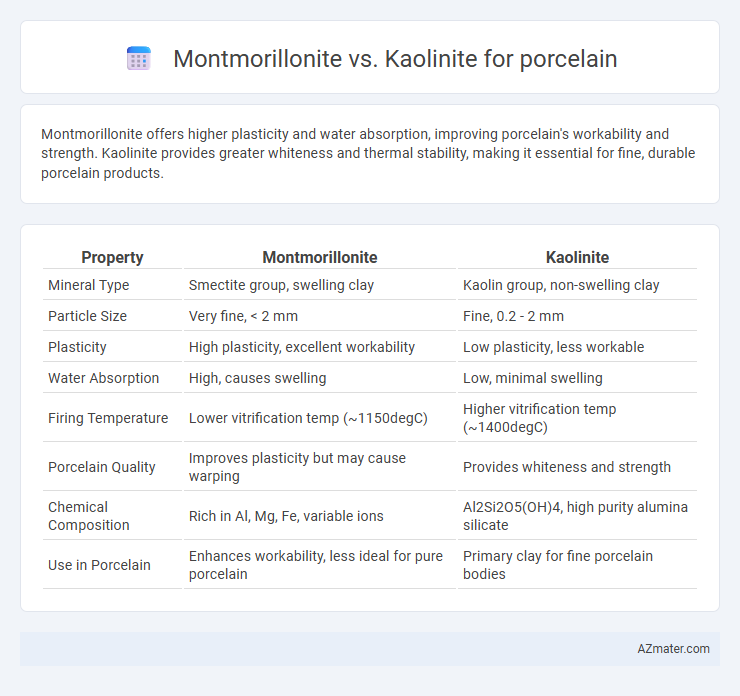Montmorillonite offers higher plasticity and water absorption, improving porcelain's workability and strength. Kaolinite provides greater whiteness and thermal stability, making it essential for fine, durable porcelain products.
Table of Comparison
| Property | Montmorillonite | Kaolinite |
|---|---|---|
| Mineral Type | Smectite group, swelling clay | Kaolin group, non-swelling clay |
| Particle Size | Very fine, < 2 mm | Fine, 0.2 - 2 mm |
| Plasticity | High plasticity, excellent workability | Low plasticity, less workable |
| Water Absorption | High, causes swelling | Low, minimal swelling |
| Firing Temperature | Lower vitrification temp (~1150degC) | Higher vitrification temp (~1400degC) |
| Porcelain Quality | Improves plasticity but may cause warping | Provides whiteness and strength |
| Chemical Composition | Rich in Al, Mg, Fe, variable ions | Al2Si2O5(OH)4, high purity alumina silicate |
| Use in Porcelain | Enhances workability, less ideal for pure porcelain | Primary clay for fine porcelain bodies |
Introduction to Montmorillonite and Kaolinite
Montmorillonite and kaolinite are two key clay minerals with distinct properties impacting porcelain production. Montmorillonite, characterized by its high swelling capacity and layered structure, enhances plasticity and workability in porcelain mixtures. Kaolinite, a non-expanding clay with a plate-like structure, provides whiteness, strength, and translucency, making it essential for fine, high-quality porcelain.
Chemical Composition Comparison
Montmorillonite contains a higher concentration of hydrated sodium, calcium, and magnesium ions within its layered structure, while Kaolinite is primarily composed of aluminum silicate with a formula of Al2Si2O5(OH)4. The presence of exchangeable cations in Montmorillonite increases its plasticity and water absorption, essential qualities influencing porcelain shaping and drying behaviors. Kaolinite's lower swelling capacity and high purity of silica and alumina make it ideal for producing durable, white, and fine-grained porcelain ceramics.
Structural Differences Between Montmorillonite and Kaolinite
Montmorillonite features a 2:1 phyllosilicate structure with two tetrahedral sheets sandwiching an octahedral sheet, providing high swelling capacity and cation exchange properties ideal for flexibility in porcelain formulations. Kaolinite has a 1:1 layered silicate structure consisting of one tetrahedral and one octahedral sheet, resulting in lower plasticity and minimal swelling, contributing to porcelain's rigidity and whiteness. These structural variances between montmorillonite and kaolinite significantly influence the mechanical strength, plasticity, and firing characteristics of porcelain ceramics.
Plasticity and Workability in Porcelain Production
Montmorillonite exhibits higher plasticity compared to kaolinite, making it more effective in enhancing the workability of porcelain clay bodies during shaping and molding. Kaolinite, while less plastic, contributes to a stronger fired structure due to its lower shrinkage and greater refractory properties, balancing the porcelain formulation. Optimal porcelain production often involves blending montmorillonite's plasticity with kaolinite's strength to improve the overall workability without compromising the final product's durability.
Firing Behavior and Thermal Properties
Montmorillonite exhibits higher plasticity and water absorption compared to kaolinite, influencing the shaping and drying stages in porcelain production. Its firing behavior includes a lower sintering temperature and greater shrinkage due to its expansive lattice structure, leading to increased vitrification and translucency in the final product. Kaolinite provides better thermal stability and lower thermal expansion, minimizing warping and cracking during firing, which is essential for maintaining porcelain integrity at high temperatures.
Impact on Porcelain Strength and Durability
Montmorillonite enhances porcelain strength and durability due to its high plasticity and swelling properties, allowing for better particle bonding and reduced porosity after firing. Kaolinite, characterized by its plate-like structure and lower plasticity, contributes to a harder but more brittle porcelain body, often resulting in increased firing temperature requirements and potential shrinkage. The balanced use of montmorillonite and kaolinite in porcelain formulations optimizes mechanical strength and resistance to thermal shock, ensuring longer-lasting ceramic products.
Effects on Porcelain Color and Texture
Montmorillonite, rich in swelling clay minerals, contributes to a more plastic and workable porcelain body but can introduce a slightly off-white or grayish tint due to its iron and magnesium content. Kaolinite, characterized by its fine particle size and high purity, produces a bright white porcelain with a smooth, dense texture, enhancing translucency and reducing firing defects. The balance between montmorillonite's plasticity and kaolinite's whiteness is crucial for optimizing porcelain color and texture in high-quality ceramic products.
Cost and Availability in the Ceramics Industry
Montmorillonite is generally more expensive and less abundant than kaolinite in the ceramics industry, making kaolinite the preferred choice for porcelain production due to its widespread availability and lower cost. Kaolinite's stable supply from numerous global deposits supports consistent manufacturing, while montmorillonite's limited sources and higher processing costs increase overall expenses. Cost efficiency and material accessibility drive manufacturers to favor kaolinite for high-quality porcelain ceramics.
Environmental Considerations and Sustainability
Montmorillonite and kaolinite differ significantly in environmental impact and sustainability when used in porcelain production. Montmorillonite has higher water absorption and swelling properties, which can result in greater energy consumption during firing but offers better plasticity, reducing raw material waste. Kaolinite, being more abundant and stable, requires less energy to process and produces less environmental pollution, making it a more sustainable choice for eco-friendly porcelain manufacturing.
Choosing the Best Clay Mineral for Porcelain
Montmorillonite offers high plasticity and excellent water absorption, crucial for shaping intricate porcelain forms, while Kaolinite provides superior whiteness and firing stability, resulting in a more translucent and durable final product. Porcelain manufacturers often prefer Kaolinite for its low shrinkage and resistance to deformation during high-temperature firing, ensuring a smooth, crack-free finish. Selecting the best clay mineral depends on the desired porcelain properties, where blending Montmorillonite's moldability with Kaolinite's firing qualities can optimize strength and aesthetic appeal.

Infographic: Montmorillonite vs Kaolinite for Porcelain
 azmater.com
azmater.com